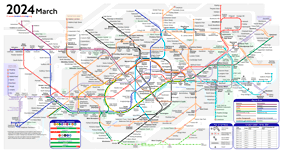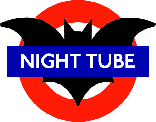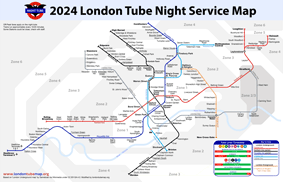London Tube Map 2024
Updated: April 2024
On our website, you will find the following information about the London Underground: maps of daytime services, fares, timetables, maps of each tube line, maps of the night tube services, and the railway lines connecting each end of Greater London.
London Tube Map Underground map with the tube lines and stations, according to the current geographical location in London.
→ Click to Zoom in <--- Download the London tube map in PDF format:
The Tube map is also available showing wheelchair-accessible stations and in 15 languages (in PDF format).
|
|||||||||||||||||||
London Tube Night Service Map
→ Click to Zoom in <---
Map based on the original work "London Underground Overground DLR Crossrail map night.svg" by Sameboat, available under the CC BY-SA 4.0 license. Modifications made by www.londontubemap.org.
|
|||||||||||||||||||
Map Key
|
|||||||||||||||||||
|
|
|||||||||||||||||||
Maps of London Tube linesIf you need information about a particular line, you can click on any of the links below and access individual maps of the London Tube and Overground lines. [ Click on a line to get more information ]
Where to buy tourist tickets online?On the Tiqets website, you can buy cheaper tickets for all kinds of museums, shows, monuments, attractions, and tours. On some items, you can save up to 20%. In most places, with these tickets, you will not have to wait in line at the entrance.
|
|||||||||||||||||||
Interesting Facts about the London Underground and its map
The London Underground, better known as the Tube, is one of the most extensive networks in the world. In London, the tube is connected and integrated with trains and trams.
There are ticket vending machines where you can buy tickets or top-up prepaid cards.
You must touch your card or ticket at the yellow reader at the beginning, and at the end of your journey.
There are different benefits available for children and elderly people.
London Underground: A Masterclass in Design
London's Tube is not just a transport system; it embodies the city's essence. Its three hallmark design elements have been trademarked, elevating London to iconic status on a global scale, truly incomparable.
- Harry Beck's visionary TUBE MAP.
- The distinctive Roundel emblem.
- The Johnston typeface, utilized across posters and maps.
The Tube map, a brainchild of Harry Beck in 1931, adopts a schematic approach, simplifying the intricate routes of the transport system (its schematic nature means it doesn't adhere to actual distances).
This map's design principle has been adopted globally across various underground and railway networks. Its influence extends beyond transport into sectors like aviation. Initially dismissed by the railway company, Beck's concept has since become a standard. Mr. Beck, working for the railway at the time, faced initial rejection of his map.
The Roundel, symbolizing the underground, features a circular motif with a bar bearing the red, white, and blue colours, conceived in 1900 and finding inspiration in Paris metro's promotional materials.
The design set is rounded off with the "Johnston" typeface, visible on maps and signage throughout the Underground, as well as on Overground and TfL-affiliated railways. This typeface was specifically crafted for the Tube.
Questions and answers
What are the London Underground zones?
- London Transport is organised into 9 concentric zones.
- Zone 1 is the historic centre. Zone 6 is the beginning of the suburbs.
- #TipForTourists When buying tickets for the London Transport, ticket machines will prompt you to select the zones to visit to give you the lowest price, all attractions are within zones 1 and 2, therefore, you should buy tickets to move between those zones.
Why are there different types of lines on London Underground maps?
- The Underground is divided into 11 lines. Each line has a different colour and it is represented by a "full line".
- Trains and Trams are represented by two parallel lines (=).
What's a railway?
- A train moves over a steel railway track. Locomotives pushed the wagons to travel over ground.
- The London Underground network is integrated with DLR trains, London Overground, and the Elizabeth Line.
What is DLR?
- It stands for Docklands Light Railway. It is a driverless train network. The DLR is similar to the Tube, but it runs above ground rather than on underground tunnels and it is divided into 6 routes.
Is Elizabeth Line a tube?
- It's a nuanced question because the Elizabeth Line, despite including the word "line" in its name, is technically a train service. The Elizabeth Line operates on traditional railway tracks, features larger carriages compared to typical Tube trains, and its doors do not open automatically like those on the Tube.
- The term "line" is often associated with underground services, but in the case of the Elizabeth Line, it refers to a railway service that operates both above and below ground.
How many lines does the London Underground have?
- The London Underground has 11 lines: Bakerloo, Central, Circle, District, Hammersmith, Jubilee, Metropolitan, Northern, Piccadilly, Victoria and Waterloo.
- The rest of the lines, although transport lines, run above ground.
Why is the London Underground called the Tube?
- It's called like that due to the tubular shape of its tunnels.
Which was the first city in the world to have a tube?
- The first city in the world to inaugurate an Underground was London
When did the London Underground open?
- The London Underground, with its first section, the Metropolitan Railway, opened in 1863. This was the world's first underground railway.
How many stations does the London Underground have?
- Nowadays it has 272 stations.
How many passengers use the London Underground every day?
- The latest figures (year 2022), show that 5 million passengers, mainly "commuters", use the Underground every day.

 On Fridays and Saturdays, London's Underground and Overground offer night services. The lines and stations that operate overnight on these days are:
On Fridays and Saturdays, London's Underground and Overground offer night services. The lines and stations that operate overnight on these days are: